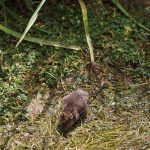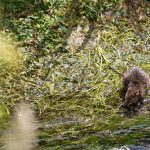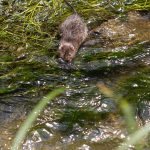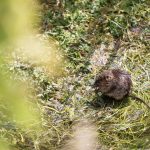Ratty’s remarkable return to the South Downs!
October 7, 2024
Once a common sight on Britain’s riverbanks, the much-adored “Ratty” has become a rarity on many of the UK’s waterways.
But now the animal made famous by The Wind in the Willows is making a remarkable comeback in the South Downs National Park, with a detailed ecological report showing that water voles are indeed thriving, and busily breeding, on the River Meon in Hampshire.
The scientific survey comes just over a decade after a local reintroduction programme of the water vole, which remains the country’s fastest declining mammal species, losing 95 per cent of its range over the past 100 years. The biggest reasons for the decline have been habitat loss and predation by the non-native American Mink.
The monitoring in the National Park revealed that the reintroduction has been a true success, with ecologists and volunteers finding over 2,500 signs of water vole activity at 27 sites along the river and its tributaries. Twenty of the recorded sites showed evidence of breeding. Since 2013, just over 2,800 water voles were released along the river and the survey indicates thousands have made the River Meon their permanent home.
Water voles are important to a river habitat as they provide a good meal for predators like otters, herons and marsh harrier. They are also known as “engineers” for thriving wetland ecosystems as their continual nipping and grazing of riverbanks helps to create flower-rich habitat for insect species such as bumblebees, moths and butterflies, which then become food for insect-eating birds and bats. Water voles’ complex underground structures are also used as refuges by a range of other small mammal species, reptiles, amphibians and insects.
Thanks to the water vole re-introduction, the otter has returned to the River Meon, with evidence there may be three breeding females on the river.
Dr Rowenna Baker, who conducted the survey with an army of National Park volunteers, also found evidence of a wealth of other wildlife along the river, including hazel dormice, hedgehog, harvest mice, brown hare, badger, grass snake, common lizard, Cetti’s warbler, kingfisher, lapwing, marsh harrier and brown trout. There was also the potential presence of a key species, Hildenbrandia rivularis, a red algae that is typically found in healthy chalk river systems.
Dr Baker said: “It’s been fantastic to find evidence that water voles are persisting at their release sites and colonising new habitat up and down the river corridor. The abundance of field signs show that water voles are now thriving on the River Meon and this is incredibly important when nationally their future still remains uncertain. It’s a real testament to the National Park and those who live and work along the river in their commitment to making it a haven for this charismatic species. On top of that, the presence of such an array of other species, many also in decline or locally rare, is equally exciting and gives a glimpse of how rich and diverse our river systems can be.”
The turnaround for the river has been made possible by the Meon Valley Partnership, which was formed in 2008 to help introduce projects to restore the waterway to good health as a functioning river and ecosystem. Decades of habitat loss, pollution and invasive species had taken their toll on the river and reduced its biodiversity. The partnership has worked with landowners to restore natural features of the river, re-introduce water voles, control American Mink populations, and improve water quality.
The survey found the areas with the highest concentration of water voles were West Meon, Funtley and Titchfield Haven Nature Reserve.
Elaina Whittaker-Slark, Lead Ranger for the Hampshire area of the National Park, said: “Unfortunately re-introductions are not always successful, so it’s wonderful to see this latest survey that shows good old ‘Ratty’ really is flourishing! It’s a good indicator of the overall health of this very rare chalk river, which has really turned a corner in the past decade or so after water voles were considered locally extinct back in 2003.
“One of the most memorable moments of the project was when we found out that marsh harriers were again breeding at Titchfield Haven. This meant that there were enough prey species like water voles for them to be able to raise a family. The food web of the river was at last complete again.
“One of the great things about the survey is that it’s shown specific areas along the river that are doing well for water voles and areas where habitat could be improved further, so it’s given us a lot of information we can use going forward.
“There’s still a lot more to be done to improve the health of our rivers, but it’s really encouraging to see what can be achieved.”
Tim Slaney, Chief Executive (Interim) for the National Park Authority, said: “We all know nature is in crisis in the UK, so it’s wonderful to be able to share this positive story of wildlife bouncing back with a little helping hand from us.
“As part of our ambitious ReNature initiative, we’re determined to turn the tide on biodiversity loss and water will continue to be a priority in our nature recovery goals. Working with partners over the coming years and decades, we would hope that the nature recovery on the River Meon can improve further and be replicated on the many other important rivers and streams in the South Downs National Park.”
Find out more about the ReNature initiative.






